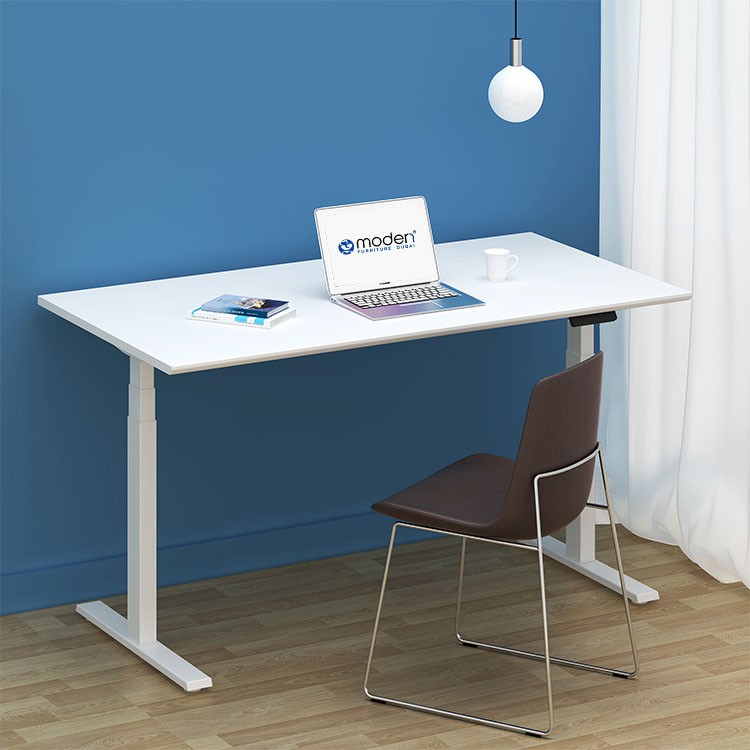
How to Select a Desk for a Dual-Monitor Setup
Introduction
A dual-monitor setup is a must for many professionals who need extra screen space for multitasking, research, or design work. However, choosing the right desk to accommodate dual monitors requires careful consideration of the desk’s size, ergonomics, and functionality. A well-chosen desk not only supports your monitors but also promotes comfort and improves productivity. In this guide, we’ll explore the key factors to consider when selecting the perfect desk for a dual-monitor setup.
1. Desk Size and Surface Area
When selecting a desk for a dual-monitor setup, the first consideration is the size of the desk. The surface area should be spacious enough to hold both monitors comfortably, along with any other equipment like a keyboard, mouse, or laptop. Ideally, you want a desk that offers sufficient space to avoid crowding your monitors, giving you room to work without distractions.
2. Adjustable Height for Comfort
One of the most important features to look for in a desk for a dual-monitor setup is adjustable height. A height-adjustable desk allows you to alternate between sitting and standing, promoting better posture and reducing strain. Ergonomically, alternating between sitting and standing can improve circulation, reduce back pain, and increase energy levels, making it an excellent choice for long hours of work.
3. Stability and Durability
The desk should be stable enough to support the weight of two monitors and other equipment without wobbling. Stability is especially important if you're using heavy monitors or adding additional accessories like a printer or external hard drive. A durable desk will ensure that your dual-monitor setup remains safe and functional for years.
4. Cable Management Features
A dual-monitor setup often comes with a variety of cables for the monitors, keyboard, mouse, and other peripherals. A desk with built-in cable management features such as cable trays, clips, or grommets can help keep these cables organized and out of sight. This not only reduces clutter but also ensures a cleaner, more efficient workspace.
5. Ergonomics and Viewing Angle
To ensure a comfortable working experience, it's essential to position your dual monitors at the right height and angle. Look for desks that allow you to adjust the height of your monitors easily and ensure that your eyes are level with the top of the screen. Proper ergonomics can help prevent neck strain and eye fatigue, which are common complaints among those who use dual-monitor setups for extended periods.
6. Storage Space
Consider desks that offer extra storage, such as drawers or shelves, to keep your workspace tidy. Having easy access to office supplies or documents while maintaining a clean desk is crucial for productivity. Desks with built-in storage help declutter the workspace, giving you more room for your monitors and creating an organized environment.
7. Material and Aesthetic Appeal
The material and design of the desk will contribute to the overall look of your workspace. Choose a desk that matches your office decor and provides a functional workspace. For a modern and sleek look, consider desks made of high-quality wood, metal, or tempered glass. Make sure the material is durable enough to handle the weight of dual monitors and other equipment.
8. Easy Setup and Assembly
Ensure that the desk is easy to assemble and set up. A desk that comes with clear instructions and all necessary hardware can save you time and effort. If you're opting for a height-adjustable desk, make sure the mechanism is simple to use and reliable.
9. Monitor Placement Flexibility
Ideally, the desk should allow for flexibility in monitor placement. Some desks offer built-in mounting options or ample space for adjustable monitor arms, which help you fine-tune the placement of your monitors for optimal viewing angles. This is particularly useful if you prefer to adjust the height or orientation of your monitors for comfort.
10. Budget Considerations
Lastly, consider your budget. While height-adjustable desks with extra features like built-in storage and cable management might be pricier, they can be a worthwhile investment for improving comfort and productivity. However, if you are on a tighter budget, you can still find desks that offer ample workspace for a dual-monitor setup without compromising on quality.
Recommended Products

-
Bugal Pro Series Dual Motor Electric Height Adjustable Standing Desk
This height-adjustable standing desk offers the perfect solution for your dual-monitor setup. It combines functionality, style, and ergonomic features, allowing you to alternate between sitting and standing throughout your workday.
Final Thoughts
Selecting the right desk for a dual-monitor setup is essential for maintaining comfort, productivity, and an organized workspace. When choosing your desk, consider factors like size, adjustability, ergonomics, and durability to ensure it meets your needs. A high-quality desk with built-in storage and cable management can also streamline your workspace and reduce distractions. Investing in a good desk will make a noticeable difference in how efficiently and comfortably you work.
FAQ
What is the ideal desk size for a dual-monitor setup?
The ideal desk size should offer enough surface area to comfortably fit both monitors side by side, along with space for your keyboard, mouse, and any other equipment. A desk that is at least 120 cm wide is recommended for dual monitors.Is a height-adjustable desk necessary for a dual-monitor setup?
While not strictly necessary, a height-adjustable desk offers flexibility and promotes better ergonomics. Alternating between sitting and standing helps reduce the strain of sitting for long hours and improves productivity.How do I manage cables for my dual-monitor setup?
Look for desks with built-in cable management options like trays, grommets, or clips to keep cables organized and prevent them from cluttering your workspace.


